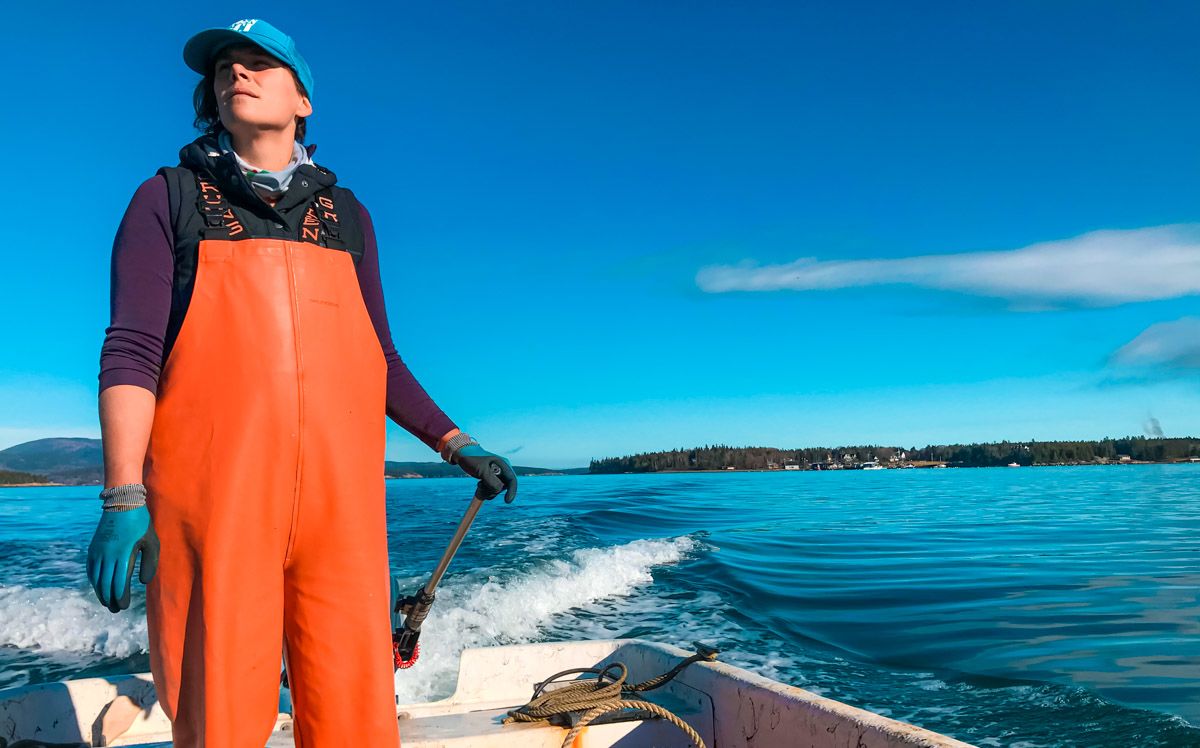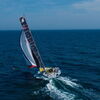A Maine oyster grower’s creed: patience, patience, patience
 Photo / Courtesy of CRANBERRY OYSTERS
Lauren Gray tows new gear to her five-acre Cranberry Oysters farm site, where she plans to plant 300,000 oyster seeds this year.
Photo / Courtesy of CRANBERRY OYSTERS
Lauren Gray tows new gear to her five-acre Cranberry Oysters farm site, where she plans to plant 300,000 oyster seeds this year.
Lauren Gray started Cranberry Oysters in 2015 as a part-time venture. In 2018, she left her job as one of two teachers in the Cranberry Isles’ two-room schoolhouse to pursue her enterprise full-time. This past spring, Cranberry Oysters, which is based on Great Cranberry Island, won the Judge’s Choice Award during Mount Desert 365’s third annual Mount Desert Business Boot Camp. Mainebiz asked Gray about her startup journey and plans for the future. Here’s an edited transcript.
Mainebiz: How did you become interested in oyster aquaculture?
Lauren Gray: Before I was a teacher, I was a writer for Commercial Fisheries News. I had to do a couple of feature stories on aquaculture in Massachusetts, so I got to visit Island Creek Oysters and East Dennis Oysters. I loved that. I was lobster fishing summers, and I loved working on the water. But I realized it wasn’t a reality for me because of the waiting lists [to get a lobster fishing license]. I wanted to work on the water and aquaculture seemed like a good fit because I could get started right away and stay close to home.
MB: How did that idea unfold?
LG: My good friend Joanna Fogg was starting her farm, Bar Harbor Oyster Co. She helped me get started. I joined Island Institute’s aquaculture cohort, went to classes, and filled out applications for limited purpose aquaculture leases [one-year 400-square-foot sites]. Those were granted and I picked four sites. The two lobster fishermen I had been working with helped me get set up. I bought 10 cages and filled out an order form for oyster seed.
MB: What does oyster seed look like?
LG: The shells are the size of your pinkie fingernail — really teeny and very brittle. I got 25,000 oyster seeds the first year and basically doubled each year after that. A single oyster cage is $150, then you have oyster bags that go in each cage, and oyster seed is expensive. I was able to self-finance and gradually scale up. In 2019, I got a standard 20-year lease of 5.25 acres. This year, I’m putting in 300,000 oyster seeds.
MB: How do you identify a good site?
LG: You need a lot of tide — the more water flow you get, the faster your oysters grow. If you can find an area that can be a little warmer, that’s good — a degree makes a huge difference. Then there’s depth. I’m in a very shallow site that warms up but also makes it challenging to sink the gear in the winter, when a huge tide can expose the gear in certain parts of my site.
MB: What equipment do you need?
LG: I was uniquely situated because my husband runs Newman & Gray Boatyard, so I already had heavy equipment such as a forklift and truck, and waterfront access. I bought a Carolina skiff and fiberglassed-in a little hauling station with an electric hauler. I had close ties with a mooring company that runs the Alvah B. barge. Matt Knox, who ran the company at the time, helped me set up a mooring system. I have just over 200 cages now.
MB: What’s been your investment?
LG: I had savings from teaching and started with about $50,000. That evaporated quickly. I got a few small grants, from the Island Institute’s Tom Glenn Fund Community Impact Fund and now the Mount Desert 365 prize. SCORE Maine was a tremendous help. I got paired with an amazing mentor, Bill Webster, and the program is free. Bill helped me with the finances.
MB: What did the prize money go to?
LG: I bought huge timbers to build a new float. I started out with a tired old float that was retired from Newman & Gray. It was sinking and we were using less and less of the surface every year. I started building the new float in February. It’s where I run my operation. It’s a whole day out there — long hours and a lot of labor. The new float will have a house with some protection and also a solar panel. I have an oyster tumbler that my father-in-law helped me make from spare parts for $500; they retail for more than $5,000.
MB: When did you get your first market size oysters?
LG: 2019. It takes four years to get a marketable crop of oysters in Maine because the water’s so cold. Sales were really small my first couple of years, because I had only planted 25,000. You have to be aware of oyster math. People say, ‘You had 25,000 oysters and you sell them for $1 each, so you should be making $25,000 in profit.’ That’s not how it works. There are so many costs. You have to count on mortality being at least 20%. And a number of things slow their growth, like cold springs when the water temperature takes a long time to warm up. So the farm is still not making a profit, but I’ve doubled sales every year.
MB: How do you harvest the oysters?
LG: The harvest is the fun part. We go out to the cages. We’ve got gloves and Grundéns [fishing apparel]. We pull up the cage with the hauler and take out the bags. We take them to float, where we have a big sorting table. We pick every oyster by hand. Over the course of their lives, I’ve touched them many times: It’s a very hands-on process. I pick by appearance. Each one represents the brand, so you have to make sure they’re super quality for the half-shell market. They have to have a really deep cup, which means it has a lot of meat.
What’s cool about the different farms is that oysters have different flavors. I’m doing surface culture, so they’re getting different food sources than a bottom farmer would. I also think they taste different every season.
MB: Can you characterize the taste?
LG: People say they’re really briny but also have that really sweet finish to them.
MB: What’s your market?
LG: I started off selling to restaurants on the Cranberry Isles and made the leap to restaurants on Mount Desert Island in the past two years. Joanna Fogg is doing distribution for me through Bar Harbor Oysters’ retail store. That’s another neat thing about the industry. It’s like microbrews — it’s not a threat to have all the different farms pop up, because each has its own flavor. I also joined the Maine Oyster Trail two years ago. The trail celebrates the little farms along the coast and gets people trying all the flavors.
MB: What are your next steps?
LG: My next step is to think about my remote geographic location, which presents a problem — but I also have one of the most picturesque operations. Scaling is the biggest thing. When you start a business, everything is so scrappy — you’re in survival mode and investing in equipment that’s going to last is difficult. Now I’m headed toward paying attention to the process and trying to streamline as I scale up. My goal is to expand my distribution on MDI.










0 Comments